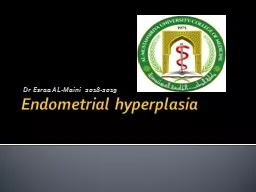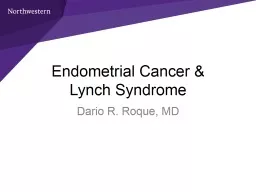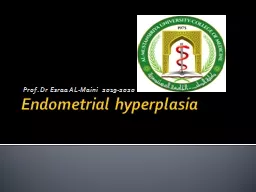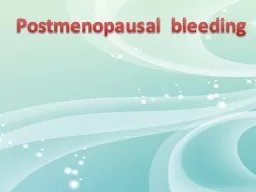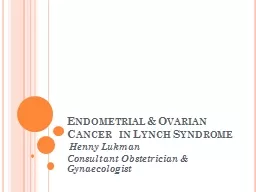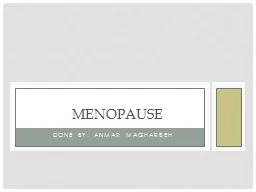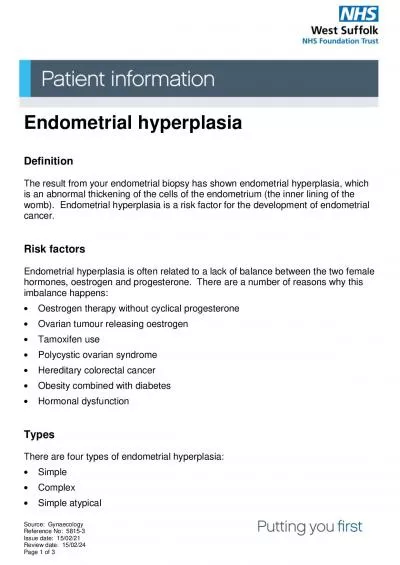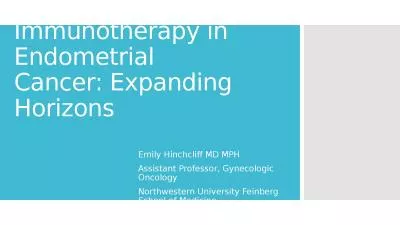PPT-ENDOMETRIAL CANCER Nomonde Mbatani
Author : adia | Published Date : 2024-01-20
Ca Endometrium Most common female genital tract cancer Developed areas South African females 7 th most common cancer 1163 according to SA National Cancer Registry
Presentation Embed Code
Download Presentation
Download Presentation The PPT/PDF document "ENDOMETRIAL CANCER Nomonde Mbatani" is the property of its rightful owner. Permission is granted to download and print the materials on this website for personal, non-commercial use only, and to display it on your personal computer provided you do not modify the materials and that you retain all copyright notices contained in the materials. By downloading content from our website, you accept the terms of this agreement.
ENDOMETRIAL CANCER Nomonde Mbatani: Transcript
Ca Endometrium Most common female genital tract cancer Developed areas South African females 7 th most common cancer 1163 according to SA National Cancer Registry The good news Prognosis excellent. Bilgin GURATES, M.D.. A. bnormal. . U. terine. . B. leeding. Causes of abnormal uterine bleeding. Current treatment options for abnormal. uterine bleeding. MEDICAL THERAPY. L. evonorgestrel. intra-uterine system (. Esraa. AL-. Maini. 2018-2019. Endometrial thickness guidelines. premenopausal women :. Endometrial thickness in normal endometrial vary according to day of cycle. ≤ 4 mm on day 4 of the menstrual cycle ≤ 8 mm by day 8. . Lynch Syndrome. Endometrial Cancer 2020. Estimated New Cases. Early Detection Makes a Difference. Endometrial Cancer Risk Factors. Chronically increased estrogen levels. Unopposed estrogen therapy. Tamoxifen. Esraa. AL-. Maini. . 2019-2020. Endometrial thickness guidelines. premenopausal women :. Endometrial thickness in normal endometrial vary according to day of cycle. ≤ 4 mm on day 4 of the menstrual cycle ≤ 8 mm by day 8. . menapause. How you will Mange her. What about history taken . confirm . menopausal, when . was your last period?. Frequency. Length. quantity of bleeding . (The woman may report individual episodes of spotting, or she may report days or months of profuse bleeding).. . Henny Lukman. Consultant Obstetrician & Gynaecologist. Cancer. General Population Risk. Syndrome Risk. Mean age of onset. 10 year survival (England & Wales). Endometrium. 3%. 40-60%. 48-55. Menopause. Menopause. is a retrospective diagnosis ,it is defined as 12 months of . amenorhhea. .. The average age at menopause is approximately 51 years. Happens gradually with irregular . anovulatory. 1 standing inflammation) is characterized by the presence of lymphocytes and other mononuclear cells in the endometrium. Inflammation may be infectious or non-infectious in origin, but is a potentia The George W. Morley Professor University of Michigan What is gynecologic cancer? begin in the female reproductive organs. The most common gynecologic cancers are endometrial cancer, ovarian cancer an Cancer Overview In the United States, the most common cancer of the female reproductive system is endometrial cancer . In endometrial cancer, cancerous cells grow in the endometrium ( the lining of ARRO Case: Early - Cancer Ankit Modh , MD (PGY - 4) Faculty Advisor: Mohamed A Elshaikh, MD Department of Radiation Oncology Henry Ford Cancer Institute Case Presentation • 70 y/o African Amer ENDOMETRIAL CANCER Treatment Algorithm : Endometrial Cancer Postmenopausal/ Abnormal Vaginal Bleeding (PAP smear as indicated ) Transvaginal USG for Endometrial Thickness (ET) Negative for m aligna logy Reference No: 5815 - 3 Issue date: 15/02/21 Review date: 15/02/24 Page 1 of 3 Endometrial h yperplasia Definition The result from your endometrial biopsy has shown endometrial hyperplasia, whi Emily Hinchcliff MD MPH. Assistant Professor, Gynecologic Oncology. Northwestern University Feinberg School of Medicine. Robert H Lurie Comprehensive Cancer Center. OUTLINE. Genetic testing: You and Your tumor.
Download Document
Here is the link to download the presentation.
"ENDOMETRIAL CANCER Nomonde Mbatani"The content belongs to its owner. You may download and print it for personal use, without modification, and keep all copyright notices. By downloading, you agree to these terms.
Related Documents


